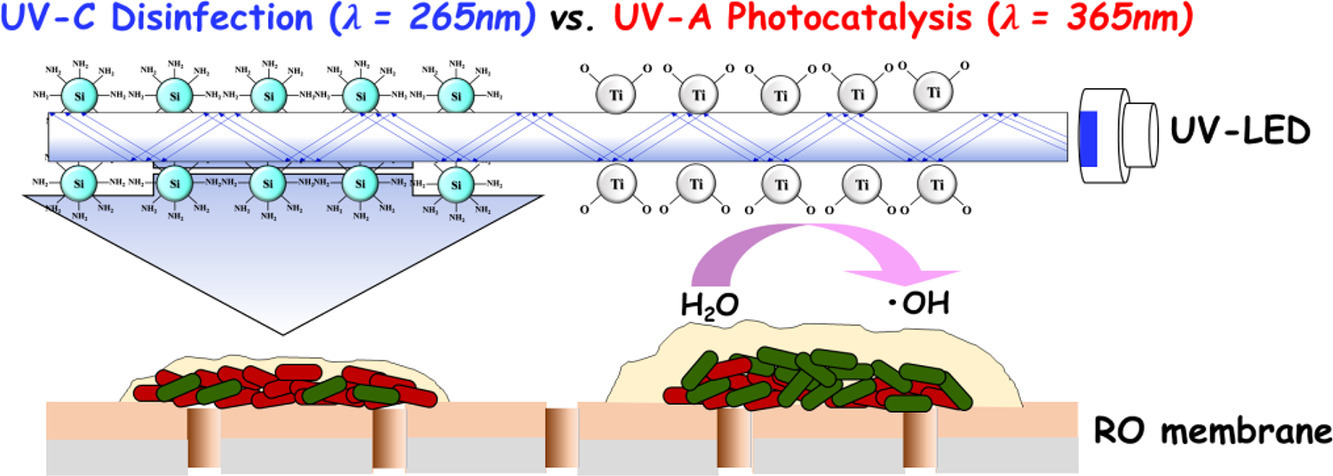Inhibition of Biofouling on Reverse Osmosis Membrane Surfaces by Germicidal Ultraviolet Light Side-Emitting Optical Fibers
Outcome/Accomplishment
Researchers at the National Science Foundation (NSF)-funded Nanosystems Engineering Research Center (NERC) for Nanotechnology Enabled Water Treatment (NEWT) at Arizona State University (ASU) and Rice University (RU) designed a novel reverse osmosis (RO) membrane apparatus equipped with side-emitting optical fibers (SEOFs) to investigate the effects of ultraviolet (UV)-SEOFs on RO membrane biofouling. The team discovered that hydroxide (OH) generated from UV-A or photocatalysis-enabled SEOFs promotes the growth of microorganisms on the RO membrane; this OH affects the degradation of the RO membrane surface by passing through the biofouling layer. In contrast, UV-C—or direct photolysis disinfection SEOFs—reduce biofouling on the RO membrane, better mitigating performance declines.
Impact/Benefits
Biofouling of membrane surfaces poses significant operational challenges and multi-billion-dollar costs for desalination and wastewater reuse applications. Ultraviolet (UV) light poses a cleaner and more efficient solution for controlling biofilms while reducing chemical usage and disinfection by-products. But delivering light to membrane surfaces in spiral-wound geometries has been a daunting challenge. NEWT's research proposes thin and flexible nano-enabled side-emitting optical fibers (SEOFs) as novel light delivery devices that enable disinfection or photocatalytic oxidation by radiating UV light from light-emitting diodes (LEDs). Such SEOFs can mitigate biofilm formation by providing an active membrane spacer on RO membranes. SEOFs that deliver a low fluence of UV-C light onto membrane surfaces provide a promising non-chemical approach for mitigating biofouling formation on RO membranes.
Explanation/Background
The NEWT research team included Hojung Rho, Pingfeng Yu, Zhe Zhou, Chung-Seop Lee, Kangmin Chon, Francois Perreault, Pedro J.J. Alvarez, Gary Amy, and Paul Westerhoff. A lab-scale RO membrane apparatus equipped with SEOFs was developed to allow comparison of UV-A (photocatalysis-enabled) versus UV-C (direct photolysis disinfection) options. The results were then corroborated by both in-situ optical coherence tomography and ex-situ measurements of biofilm growth on the membranes.
Systems with UV-C light formed thinner—but denser—biofilms, prevented permeate flux declines due to biofouling, and maintained the highest salt rejection. Transcriptomic analysis also showed that UV-C SEOFs down-regulated quorum sensing and surface attachment genes; whereas UV-A SEOFs upregulated quorum sensing, surface attachment, and oxidative stress genes, resulting in higher extracellular polymeric substances (EPS) accumulation on membrane surfaces. The work was published in Water Research, Vol. 224 in October 2022.
Location
Houston, Texaswebsite
Start Year
Energy and Sustainability
Energy, Sustainability, and Infrastructure
Lead Institution
Core Partners
Fact Sheet
Outcome/Accomplishment
Researchers at the National Science Foundation (NSF)-funded Nanosystems Engineering Research Center (NERC) for Nanotechnology Enabled Water Treatment (NEWT) at Arizona State University (ASU) and Rice University (RU) designed a novel reverse osmosis (RO) membrane apparatus equipped with side-emitting optical fibers (SEOFs) to investigate the effects of ultraviolet (UV)-SEOFs on RO membrane biofouling. The team discovered that hydroxide (OH) generated from UV-A or photocatalysis-enabled SEOFs promotes the growth of microorganisms on the RO membrane; this OH affects the degradation of the RO membrane surface by passing through the biofouling layer. In contrast, UV-C—or direct photolysis disinfection SEOFs—reduce biofouling on the RO membrane, better mitigating performance declines.
Location
Houston, Texaswebsite
Start Year
Energy and Sustainability
Energy, Sustainability, and Infrastructure
Lead Institution
Core Partners
Fact Sheet
Impact/benefits
Biofouling of membrane surfaces poses significant operational challenges and multi-billion-dollar costs for desalination and wastewater reuse applications. Ultraviolet (UV) light poses a cleaner and more efficient solution for controlling biofilms while reducing chemical usage and disinfection by-products. But delivering light to membrane surfaces in spiral-wound geometries has been a daunting challenge. NEWT's research proposes thin and flexible nano-enabled side-emitting optical fibers (SEOFs) as novel light delivery devices that enable disinfection or photocatalytic oxidation by radiating UV light from light-emitting diodes (LEDs). Such SEOFs can mitigate biofilm formation by providing an active membrane spacer on RO membranes. SEOFs that deliver a low fluence of UV-C light onto membrane surfaces provide a promising non-chemical approach for mitigating biofouling formation on RO membranes.
Explanation/Background
The NEWT research team included Hojung Rho, Pingfeng Yu, Zhe Zhou, Chung-Seop Lee, Kangmin Chon, Francois Perreault, Pedro J.J. Alvarez, Gary Amy, and Paul Westerhoff. A lab-scale RO membrane apparatus equipped with SEOFs was developed to allow comparison of UV-A (photocatalysis-enabled) versus UV-C (direct photolysis disinfection) options. The results were then corroborated by both in-situ optical coherence tomography and ex-situ measurements of biofilm growth on the membranes.
Systems with UV-C light formed thinner—but denser—biofilms, prevented permeate flux declines due to biofouling, and maintained the highest salt rejection. Transcriptomic analysis also showed that UV-C SEOFs down-regulated quorum sensing and surface attachment genes; whereas UV-A SEOFs upregulated quorum sensing, surface attachment, and oxidative stress genes, resulting in higher extracellular polymeric substances (EPS) accumulation on membrane surfaces. The work was published in Water Research, Vol. 224 in October 2022.

